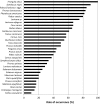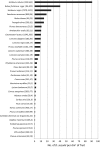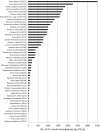Non-crop plants used as hosts by Drosophila suzukii in Europe
- PMID: 28275324
- PMCID: PMC5318492
- DOI: 10.1007/s10340-016-0755-6
Non-crop plants used as hosts by Drosophila suzukii in Europe
Abstract
The invasive spotted wing drosophila Drosophila suzukii, a fruit fly of Asian origin, is a major pest of a wide variety of berry and stone fruits in Europe. One of the characteristics of this fly is its wide host range. A better knowledge of its host range outside cultivated areas is essential to develop sustainable integrated pest management strategies. Field surveys were carried out during two years in Italy, the Netherlands and Switzerland. Fruits of 165 potential host plant species were collected, including mostly wild and ornamental plants. Over 24,000 D. suzukii adults emerged from 84 plant species belonging to 19 families, 38 of which being non-native. Forty-two plants were reported for the first time as hosts of D. suzukii. The highest infestations were found in fruits of the genera Cornus, Prunus, Rubus, Sambucus and Vaccinium as well as in Ficus carica, Frangula alnus, Phytolacca americana and Taxus baccata. Based on these data, management methods are suggested. Ornamental and hedge plants in the vicinity of fruit crops and orchards can be selected according to their susceptibility to D. suzukii. However, the widespread availability and abundance of non-crop hosts and the lack of efficient native parasitoids suggest the need for an area-wide control approach.
Keywords: Fruit fly; Host range; Invasive species; Spotted wing drosophila.
Figures




References
-
- Asplen MK, Anfora G, Biondi A, Choi DS, Chu D, Daane KM, Gibert P, Gutierrez AP, Hoelmer KA, Hutchison WD, Isaacs R, Jiang Z-L, Kárpáti Z, Kimura M, Pascual M, Philips CR, Plantamp C, Ponti L, Vétek G, Vogt H, Walton VM, Yu Y, Zappalá L, Desneux N. Invasion biology of spotted-wing Drosophila (Drosophila suzukii): a global perspective and future priorities. J Pest Sci. 2015;88:469–494. doi: 10.1007/s10340-015-0681-z. - DOI
-
- Baroffio C, Fischer S, Kehrli P, Kuske S, Linder C, Mazzi D, Richoz P (2014) Attractivité des plantes face à la Drosophile suzukii. Plantes, Agroscope Fiche technique No. 3. Ed. Agroscope, Conthey
-
- Carton Y, Bouléreau M, van Alphen JJ, van Lenteren JC. The Drosophila parasitic wasps. In: Ashburner CT, editor. The genetics and biology of Drosophila. London: Academic Press; 1986. pp. 347–393.
LinkOut - more resources
Full Text Sources
Other Literature Sources
Molecular Biology Databases
